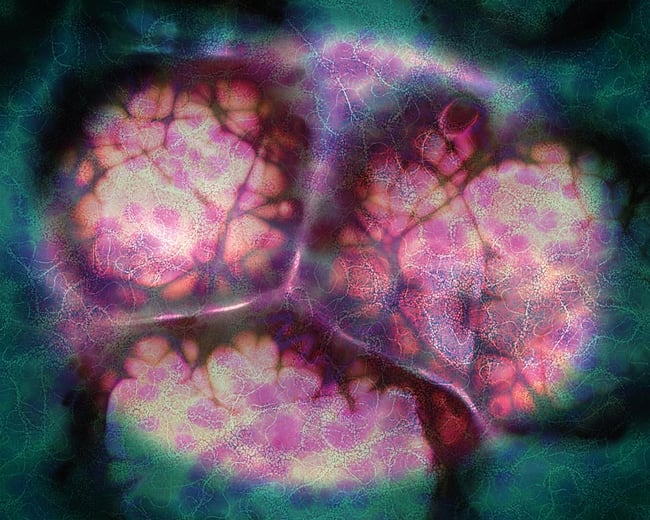Keywords:
By Simon Fogarty
(Part 3 of 3: Read Part 2) In the first part of this series, we introduced you to imatinib (Gleevec). This drug was originally launched in 2001 as a potent treatment for chronic myeloid leukemia (CML). It also proved to be effective against a number of other cancers. Here we look at possibilities for individualized treatment.
Let’s make this personal - A more individual treatment
Before the introduction of Gleevec, a diagnosis of CML was effectively a death sentence. The initial promise of spectacular results in treatment were, however, dampened somewhat by the development of resistance. But genetic research is now changing the rules.
\
CML has a relatively simple cause – parts of chromosomes 9 and 22 switch places so that part of a region on chromosome 22 called BCL is fused with the ABL gene on chromosome 9. It is the formation of this BCR-ABL gene that leads to CML.
Dr. Charles Sawyer and his colleagues at Memorial Sloan Kettering Cancer Center who had worked on imatinib discovered that the resistance arose due to a new mutation that caused the BCR-ABL protein to change its shape so that the drug could not work. But there was another drug, dasatinib (Sprycel) that inhibits BCR-ABL in its other shape.
The research team therefore ran a clinical trial that included a genetic test to determine what mutations the patient had in order to guide the treatment with imatinib or dasatinib. A study was run in 2011, which showed that CML patients whose disease was in remission after two years of treatment had the same life expectancy as those who have never had this disease.
Matching the treatment to the individual patient’s cancer type in this way can be expected to be a cornerstone in the treatment of many cancer forms in the future. It is also one way of circumventing resistance. This type of precision or personalized medicine is a further development of, for example, testing estrogen-receptor status before treating breast cancer with tamoxifen – as we mentioned in the first part of this series. In the same way, there are polymorphisms in the transporter proteins that eject anticancer drugs from cancer cells. Selecting the most suitable therapy for a patient in the future could involve a genetic test to determine which form of pump their cancer cells use.
The promise of cutting-edge technology
Looking into the future, CRISPR/Cas9 is an innovative technology for cut-and-paste genetic manipulation that brings a razor-sharp molecular scalpel to the research lab. This revolutionary gene-editing technique involves using target-specific RNA to guide an endonuclease to a selected sequence to be edited. CRISPR simplifies the process of deleting, adding, or modifying genes.
Dr. Luo and his group at the National Cancer Institute’s Center for Cancer Research used CRISPR/Cas9 technology in the search for new druggable targets. They have created libraries of cells, each with a unique gene that has been knocked out. These libraries can be used to identify potential combination therapies that will inhibit the evolution of drug resistance in tumors. For example, cancer cells can be treated with a low, sublethal dose of the drug to identify any genes that when knocked out increase drug efficacy. These genes could be targets for a new drug to be used in combination treatment.
CRISPR can also be used to study drug resistance by treating a cancer cell line with a high concentration of the drug, and determining which genes, when knocked out by CRISPR, render the cells resistant. This information could help in the development of second line treatments.
Beating the body at its own game
At the end of the day, successful cancer treatment involves getting the right drug (or drugs) to the intended target for long enough to knock out the cancer cells without catastrophic side-effects. This will involve exploiting weaknesses in the cancer cell’s complex molecular web of pathways and even outwitting its own defense mechanisms to ensure the selection process is shifted so that normal healthy cells prevail.
Further reading
A Story of Discovery: Gleevec Transforms Cancer Treatment for Chronic Myelogenous Leukemia, National Cancer Institute: http://www.cancer.gov/research/progress/discovery/gleevec
The Emperor of All Maladies: A Biography of Cancer, Siddhartha Mukherjee. Published November 2010. ISBN 978-1-4391-0795-9
Mechanisms and insights into drug resistance in cancer. Hiba Zahreddine and Katherine L.B. Borden Frontiers in Pharmacology, published: 14 March 2013 doi: 10.3389/fphar.2013.00028
The Evolution of a Lifesaving Drug: A Scientist Reflects Memorial Sloan Kettering Cancer Center: https://www.mskcc.org/blog/evolution-life-saving-drug-scientist-reflects
CRISPR: Genome Editing Comes of Age, National Cancer Institute: http://www.cancer.gov/about-cancer/causes-prevention/research/crispr
Prediction of Cancer Drug Resistance and implications for Personalized Medicine Manfred Volm and Thomas Efferth Frontiers in Oncology 1 December 2015 Volume 5 doi: 10.3389/fonc.2015.00282
Keywords:
About the author

Martin Braendle
Martin Braendle has a broad background in communications, holistically covering all areas from investor to product communications. He is passionate about the life sciences industry and the trained economist can’t think of any better motivation for work than at the end of the day helping people and improving health care. After helping biotech companies to develop new drugs for many years, he joined Tecan in 2008. At Tecan Group, Martin is a VP and member of the Extended Management Board.










